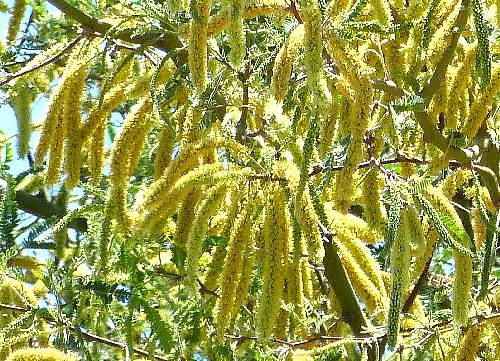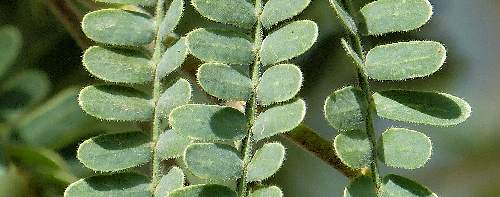Growing Neltuma velutina:
Velvet Mesquite
Back to Trees and Palms
Description
Form: A single or multi-trunked tree.
Leaf retention: Deciduous.
Growth rate: Moderate.
Mature Size: 30-40' (9-12m) high. With age, its width may considerably exceed its height.
Flowers: Yellow to cream colored, bottlebrush shaped, often profusely clustered, fragrant.
Bloom: Spring.
Fruit: A seed pod, light tan, cylindrical, straight to slightly curved, constricted around the seeds. The pods and seeds are edible, often ground into a flour.
Leaves: Green, oval, compound leaflets, covered with fine hairs which give it the name "velvet" mesquite. This tree provides moderate to dense shade.
Stems: 1-2" (2.5-5cm) long straight spines. Young stems are smooth, green and photosynthesizing. Older branches have brown bark that roughens with age.
Roots: Nitrogen-fixing*, with a deep taproot, aggressive. These trees often sucker from their roots, but this behavior diminishes with age.
Wildlife: The flowers attract bees. The seed pods are eaten by birds and mammals, including cattle.
Toxic / Danger: Spines.
Origin: California through New Mexico and Mexico.
Form: A single or multi-trunked tree.
Leaf retention: Deciduous.
Growth rate: Moderate.
Mature Size: 30-40' (9-12m) high. With age, its width may considerably exceed its height.
Flowers: Yellow to cream colored, bottlebrush shaped, often profusely clustered, fragrant.
Bloom: Spring.
Fruit: A seed pod, light tan, cylindrical, straight to slightly curved, constricted around the seeds. The pods and seeds are edible, often ground into a flour.
Leaves: Green, oval, compound leaflets, covered with fine hairs which give it the name "velvet" mesquite. This tree provides moderate to dense shade.
Stems: 1-2" (2.5-5cm) long straight spines. Young stems are smooth, green and photosynthesizing. Older branches have brown bark that roughens with age.
Roots: Nitrogen-fixing*, with a deep taproot, aggressive. These trees often sucker from their roots, but this behavior diminishes with age.
Wildlife: The flowers attract bees. The seed pods are eaten by birds and mammals, including cattle.
Toxic / Danger: Spines.
Origin: California through New Mexico and Mexico.
Cultivation and Uses
USDA hardiness zones: 7b-10.
Heat tolerant: Yes.
Drought tolerant: Yes.
Sun: Full sun.
Soil: Well draining, dry, low in organic content, pH 6.6-8.5 (neutral to alkaline). *Do not use a nitrogen fertilizer.
Water after becoming established: No care is needed after the first year. Water at the drip line no more than once every two months in a severe drought if desired.
First Year Care: This tree may need staking the first year. It will need to be watered deeply every week at the drip line to establish a strong root system.
Prune: This tree can profusely grow new stems, and sucker from its roots, after pruning, so especially winter pruning, and possibly any pruning, should be avoided. If cut to the ground, it will grow new trunks from its roots. Prune the lowest branches only in the summer, if at all. Do not thin branches by more than 20% to avoid stem sunburn which encourages insect pests. If it grows into a large shrub, it might be best to leave it that way. Remove any mistletoe infections yearly, in the winter after all leaves have dropped.
Litter: Seedpods.
Propagation: Scarified seed.
Pests: Mistletoe is common if there are other trees with mistletoe infections nearby.
Uses: Ornamental, low water (xeriscape) garden, edible seedpods.
USDA hardiness zones: 7b-10.
Heat tolerant: Yes.
Drought tolerant: Yes.
Sun: Full sun.
Soil: Well draining, dry, low in organic content, pH 6.6-8.5 (neutral to alkaline). *Do not use a nitrogen fertilizer.
Water after becoming established: No care is needed after the first year. Water at the drip line no more than once every two months in a severe drought if desired.
First Year Care: This tree may need staking the first year. It will need to be watered deeply every week at the drip line to establish a strong root system.
Prune: This tree can profusely grow new stems, and sucker from its roots, after pruning, so especially winter pruning, and possibly any pruning, should be avoided. If cut to the ground, it will grow new trunks from its roots. Prune the lowest branches only in the summer, if at all. Do not thin branches by more than 20% to avoid stem sunburn which encourages insect pests. If it grows into a large shrub, it might be best to leave it that way. Remove any mistletoe infections yearly, in the winter after all leaves have dropped.
Litter: Seedpods.
Propagation: Scarified seed.
Pests: Mistletoe is common if there are other trees with mistletoe infections nearby.
Uses: Ornamental, low water (xeriscape) garden, edible seedpods.
Comments
This plant is a member of the Legume family (Fabaceae). Its scientific synonym is Prosopis velutina. While it is not overly attractive, it is a survivor in very hot, dry environments and needs no care after the first year in the ground except for mistletoe removal every winter.
Do you have additional information or a different experience for these plants that you would like to share? Email info@GardenOracle.com. All contributions are welcome and appreciated.
This plant is a member of the Legume family (Fabaceae). Its scientific synonym is Prosopis velutina. While it is not overly attractive, it is a survivor in very hot, dry environments and needs no care after the first year in the ground except for mistletoe removal every winter.
Do you have additional information or a different experience for these plants that you would like to share? Email info@GardenOracle.com. All contributions are welcome and appreciated.




Latest update: July, 2024
© 2008-2025 by GardenOracle.com

